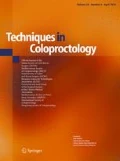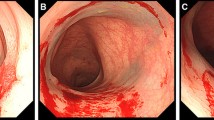Abstract
Background
Different markers have been used preoperatively to mark colonic lesions, especially India ink. In recent years, another kind of marker has been developed: sterile carbon particle suspension (SCPS). No comparison between these two markers has yet been made. The aim of the present study was to compare the pyrogenic, inflammatory and intraperitoneal effect of these two markers.
Methods
From September 2015 to December 2018, adult patients who were candidates for elective laparoscopic colon resection were randomized to the SCPS or conventional India ink injection group using computer-based randomization. The primary endpoint of the study was the presence of intraoperative adhesions related to the endoscopic tattoo. Secondary endpoints were differences in white blood cell, C-reactive protein, and fibrinogen levels as well as, abdominal pain and body temperature at baseline (before endoscopic tattooing) and 6 and 24 h after colonoscopy. Finally, the visibility of the tattoo during the minimally invasive intervention was assessed.
Results
Ninety-four patients were included in the study, 47 for each arm. There were 45/94 females (47.9%) and 49/94 males (52.1%), with a median age of 67.85 ± 9.22 years. No differences were found between groups in WBC, fibrinogen levels, body temperature or VAS scores, but we documented significantly higher CRP values at 6 and 24 h after endoscopic tattooing with India ink injection. There were significantly fewer adhesions in the SCPS Endoscopic Marker group. All the endoscopic tattoos were clearly visible.
Conclusions
SCPS is an effective method for tattooing colonic lesions and has a better safety profile than traditional India ink in terms of post-procedure inflammatory response and intraoperative bowel adhesions.
Clinical trial registration
clinicaltrials.gov (ID: NCT03637933).

Similar content being viewed by others
References
Vignati P, Welch JP, Cohen JL (1994) Endoscopic localization of colon cancers. Surg Endosc 8:1085–1087
Yeung JM, Maxwell-Armstrong C, Acheson AG (2009) Colonic tattooing in laparoscopic surgery—making the mark? Colorectal Dis 11:527–530
Zühlke HV, Lorenz EM, Straub EM, Savvas V (1990) Pathophysiology and classiication of adhesions. Langenbecks Arch Chir Suppl II Verh Dtsch Ges Chir. 1009–1016
Holzman MD, Eubanks S (1997) Laparoscopic colectomy. prospects and problems. Gastrointest Endosc Clin N Am 7:525–539 (Review)
Conaghan P, Maxwell-Armstrong C, Garrioch M, Hong L, Acheson A (2011) Leaving a mark: the frequency and accuracy of tattooing prior to laparoscopic colorectal surgery. Colorectal Dis 13:1184–1187
Beretvas RI, Ponsky J (2001) Endoscopic marking: an adjunct to laparoscopic gastrointestinal surgery. Surg Endosc 15:1202–1203
Ellis KK, Fennerty MB (1997) Marking and identifying colon lesions. Tattoos, clips, and radiology in imaging the colon. Gastrointest Endosc Clin N Am 7:401–411
Feingold DL, Addona T, Forde KA et al (2004) Safety and reliability of tattooing colorectal neoplasms prior to laparoscopic resection. J Gastrointest Surg 8:543–546
Fu KI, Fujii T, Kato S et al (2001) A new endoscopic tattooing technique for identifying the location of colonic lesions during laparoscopic surgery: a comparison with the conventional technique. Endoscopy 33:687–691
Ponsky JL, King JF (1975) Endoscopic marking of colonic lesions. Gastrointest Endosc 22:42–43
Kim DW, Sohn DK, Choi HS et al (2006) Safety and efficacy of colonoscopic tattooing of a colorectal neoplasm prior to a laparoscopic resection. J Korean Soc Coloproctol 22:97–102
Arteaga-Gonzàlez I, Martìn-Malagòn A, Fernàndez EM, Arranz-Duràn J, Parra-Blanco A, Nicolas-Perez D, Quintero-Carriòn E, Luis HD, Carrillo-Pallares A (2006) The use of preoperative endoscopic tattooing in laparoscopic colorectal cancer surgery for endoscopically advanced tumors: a prospective comparative clinical study. World J Surg 30:605–611
Bang CS, Kim YS, Baik GH, Han SH (2014) Colonic abscess induced by India ink tattooing. Korean J Gastroenterol 64:45–48
Park SI, Genta RS, Romeo DP, Weesner RE (1991) Colonic abscess and focal peritonitis secondary to India ink tattooing of the colon. Gastrointest Endosc 37:68–71
Coman E, Brandt LJ, Brenner S, Frank M, Sablay B, Bennett B (1991) Fat necrosis and inflammatory pseudotumor due to endoscopic tattooing of the colon with India ink. Gastrointest Endosc 37:65–68
Shatz BA, Weinstock LB, Swanson PE, Thyssen EP (1997) Long-term safety of India ink tattoos in the colon. Gastrointest Endosc 45:153–156
Fennerty MB, Sampliner RE, Hixson LJ, Garewal HS (1992) Effectiveness of India ink as a long-term colonic mucosal marker. Am J Gastroenterol 87:79–81
Nizam R, Siddiqi N, Landas SK, Kaplan DS, Holtzapple PG (1996) Colonic tattooing with India ink: benefits, risks, and alternatives. Am J Gastroenterol 91:1804–1808
Lightdale CJ (1991) India ink colonic tattoo: blots on the record. Gastrointest Endosc 37:68–71
Lane KL, Vallera R, Washington K, Gottfried MR (1996) Endoscopic tattoo agents in the colon. Tissue responses and clinical implications. Am J Surg Pathol 20:1266–1270
Hammond DC, Lane FR, Welk RA, Madura MJ, Borreson DK, Passinault WJ (1989) Endoscopic tattooing of the colon. An experimental study. Am Surg 55:457–461
Coccolini F, Ansaloni L, Manfredi R, Campanati L, Poiasina E, Bertoli P et al (2013) Peritoneal adhesion index (PAI): proposal of a score for the “ignored iceberg” of medicine and surgery. World J Emerg Surg 8:6
Ten Broek RPG, Krielen P, Di Saverio S, Coccolini F, Biffl WL, Ansaloni L, Velmahos GC et al (2018) Bologna guidelines for diagnosis and management of adhesive small bowel obstruction (ASBO): 2017 update of the evidence-based guidelines from the world society of emergency surgery ASBO working group. World J Emerg Surg 13:24
Yano H, Okada K, Monden T (2003) Adhesion ileus caused bytattoo-marking: unusual complication after laparoscopicsurgery for early colorectal cancer. Dis Colon Rectum 46:987
Askin MP, Waye JD, Fiedler L, Harpaz N (2002) Tattoo of colonic neoplasms in 113 patients with a new sterile carbon compound. Gastrointest Endosc 56:339–342
Dell’Abate P, Iosca A, Galimberti A, Piccolo P, Soliani P, Foggi F (1999) Endoscopic preoperative colonic tattooing: a clinical and surgical complication. Endoscopy 31:271–273
Funding
None for all authors.
Author information
Authors and Affiliations
Corresponding author
Ethics declarations
Conflict of interest
The authors declare that they have no conflict of interest.
Ethical approval
This study was approved by Ethics Committee of Federico II University.
Informed consent
A written informed consent was obtained from all the study participants before enrollment in the study.
Additional information
Publisher's Note
Springer Nature remains neutral with regard to jurisdictional claims in published maps and institutional affiliations.
Rights and permissions
About this article
Cite this article
Milone, M., Vignali, A., Manigrasso, M. et al. Sterile carbon particle suspension vs India ink for endoscopic tattooing of colonic lesions: a randomized controlled trial. Tech Coloproctol 23, 1073–1078 (2019). https://doi.org/10.1007/s10151-019-02101-y
Received:
Accepted:
Published:
Issue Date:
DOI: https://doi.org/10.1007/s10151-019-02101-y




